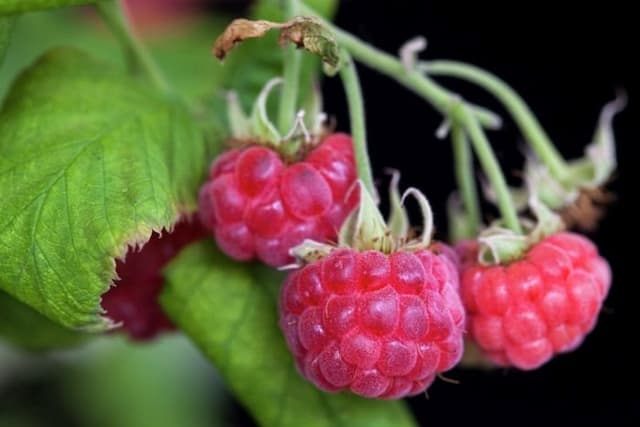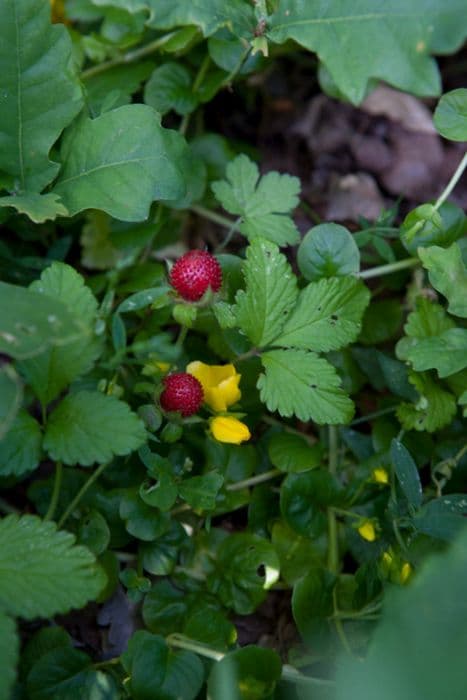Cherry Laurel Prunus laurocerasus 'Rotundifolia'

ABOUT
The Prunus laurocerasus 'Rotundifolia', commonly known as Cherry Laurel, is an ornamental plant known for its lush, glossy green foliage. The leaves are broad, oval-shaped with a pointed tip, and they often have a leathery texture that contributes to the plant's robust appearance. Cherry Laurel produces clusters of small, creamy-white flowers that can add a subtle yet attractive contrast to its dark leaves. These flowers have a pleasing fragrance that can be detected when blooming, typically in the spring. Following the flowering season, the plant bears small, cherry-like fruits that can range in color from red to black when ripe. The overall form of the Cherry Laurel is dense and compact, making it suitable for use as a hedge or privacy screen in garden landscapes. It's an evergreen shrub, so the foliage remains on the plant year-round, providing continuous greenery regardless of the season.
About this plant
 Names
NamesFamily
Rosaceae.
Synonyms
Cherry Laurel, English Laurel, Common Laurel, Rotundifolia.
Common names
Prunus laurocerasus 'Rotundifolia'.
 Toxicity
ToxicityTo humans
Cherry laurel, including the 'Rotundifolia' variety, is toxic to humans. The plant contains cyanogenic glycosides, primarily in its leaves and seeds, that can release cyanide when ingested. Symptoms of cherry laurel poisoning may include difficulty breathing, weakness, headaches, nausea, vomiting, excessive salivation, dizziness, and, in severe cases, convulsions, coma, and even death due to respiratory failure. It is important for humans to avoid ingesting any part of this plant.
To pets
Cherry laurel, including the 'Rotundifolia' variety, is also toxic to pets. Like in humans, the plant's toxicity comes from cyanogenic glycosides, which are present in all parts of the plant, but especially concentrated in the leaves and seeds. If pets consume cherry laurel, they may exhibit symptoms such as drooling, loss of appetite, vomiting, diarrhea, abdominal pain, weakness, and in more severe cases, difficulty breathing, convulsions, and even death from cyanide poisoning. It is vital to prevent pets from ingesting any part of this plant.
 Characteristics
CharacteristicsLife cycle
Perennials
Foliage type
Evergreen
Color of leaves
Green
Flower color
White
Height
10-15 feet (3-4.5 meters)
Spread
6-10 feet (1.8-3 meters)
Plant type
Shrub
Hardiness zones
7
Native area
Southeastern Europe, Southwest Asia
Benefits
 General Benefits
General Benefits- Easy to Grow: Prunus laurocerasus 'Rotundifolia', commonly known as Cherry Laurel, is a hardy plant that adapts to a wide range of soil types and conditions, making it ideal for gardeners of all experience levels.
- Privacy Screen: With its dense, evergreen foliage, Cherry Laurel is perfect for creating privacy hedges or screens, blocking out unwanted views or noise.
- Low Maintenance: Once established, Cherry Laurel requires minimal care beyond occasional pruning to maintain its shape and size.
- Drought Tolerant: This variety of Cherry Laurel is resistant to drought, making it suitable for regions with water restrictions or for gardeners seeking low-water plants.
- Wildlife Habitat: The thick foliage of the Cherry Laurel provides shelter and nesting sites for birds, while the flowers attract pollinators such as bees and butterflies.
- Ornamental Value: Cherry Laurel features shiny, dark green leaves and produces white flower spikes in the spring, adding aesthetic value to the landscape year-round.
 Medical Properties
Medical PropertiesThis plant is not used for medical purposes.
 Air-purifying Qualities
Air-purifying QualitiesThis plant is not specifically known for air purifying qualities.
 Other Uses
Other Uses- Privacy Screening: The Cherry Laurel 'Rotundifolia' is commonly used as a dense hedging plant, providing privacy for gardens and outdoor areas.
- Noise Reduction: Due to its thick foliage, it can help absorb urban noise when planted along roads or around properties.
- Windbreak: Its robust growth makes it effective at providing protection against winds when planted in rows or groups.
- Ornamental Topiary: The Cherry Laurel can be trimmed and shaped into various forms, making it a good candidate for topiary art.
- Wood Crafting: Although not commonly exploited, the wood from Cherry Laurel can be used for crafting small wooden objects or inlays.
- Urban Wildlife Shelter: Provides habitat and shelter for birds and other urban wildlife, creating a mini-ecosystem within its branches.
- Erosion Control: The plant’s root system can help stabilize soil on slopes, preventing erosion.
- Tannin Extraction: The bark of Cherry Laurel has been used historically to extract tannins for use in dyes and tanning leather.
- Photography: The dense, evergreen foliage provides an excellent dark green backdrop for plant and garden photography.
- Seasonal Decoration: Branches can be cut and used for greenery in floral arrangements or holiday decor due to their lush appearance.
Interesting Facts
 Feng Shui
Feng ShuiThe Cherry Laurel is not used in Feng Shui practice.
 Zodiac Sign Compitability
Zodiac Sign CompitabilityThe Cherry Laurel is not used in astrology practice.
 Plant Symbolism
Plant Symbolism- Victory: As a member of the laurel family, Prunus laurocerasus 'Rotundifolia', commonly known as Cherry Laurel, shares the symbolism of victory and triumph often associated with ancient Greek and Roman crowns made from laurel leaves.
- Protection: Cherry Laurel foliage was traditionally used to ward off evil spirits, and its evergreen leaves symbolize protection and the preservation of life throughout the year.
- Peace: Due to its dense foliage and the capacity to create impenetrable hedges, Cherry Laurel is sometimes associated with peace and the creation of safe, private spaces away from the outside world.
- Prosperity: The robust growth and lush appearance of Cherry Laurel can represent prosperity and success, as it is often seen thriving in a variety of conditions.
 Water
WaterCherry laurels, including 'Rotundifolia', should be watered deeply and thoroughly, ensuring the soil is moist but not waterlogged. When first planted, water them twice a week with about 1-2 gallons per plant, depending on the size. Once established, they typically need watering once every 7-10 days, increasing to twice weekly in extreme heat or drought conditions. During the colder months, you can reduce watering frequency as the plant's water requirements decrease. Be mindful not to overwater as this can lead to root rot.
 Light
LightCherry laurels, including 'Rotundifolia', prefer dappled sunlight or partial shade. They thrive best when they're protected from the harsh afternoon sun, so a spot that receives morning sunlight with afternoon shade would be ideal. They can also adapt to full sun if acclimated properly, but ensure they have adequate water to prevent stress from the intense light.
 Temperature
TemperatureCherry laurels, like 'Rotundifolia', are hardy and can tolerate a range of temperatures, but they flourish in conditions between 60°F and 75°F. They can survive minimum temperatures down to about -10°F and maximum temperatures well into the 90s°F, but prolonged exposure to temperatures outside their comfort zone can stress the plants.
 Pruning
PruningPrune cherry laurels like 'Rotundifolia' to maintain shape and encourage bushy growth. Pruning should be done in late winter or early spring before new growth begins. Trim back any dead or crossing branches and thin out the plant as needed to allow light and air to penetrate the center. An annual pruning will typically suffice, with additional light pruning as needed through the growing season to remove damaged or overgrown branches.
 Cleaning
CleaningAs needed
 Soil
SoilCherry Laurel (Prunus laurocerasus 'Rotundifolia') thrives in a well-draining, loamy soil mix with a pH between 6.0 and 8.0. A mix of garden soil, compost, and perlite or sand could offer the ideal structure and fertility.
 Repotting
RepottingCherry Laurels are generally planted in the landscape and don't require frequent repotting. If grown in containers, young plants may need repotting every 2-3 years, while mature plants can be repotted less frequently.
 Humidity & Misting
Humidity & MistingCherry Laurel tolerates a wide range of humidity levels but prefers average to high humidity. No specific level is critical for its success, making it adaptable to outdoor humidity conditions.
 Suitable locations
Suitable locationsIndoor
Ensure bright light, cool temps, and moist soil for indoor Cherry Laurel.
Outdoor
Plant in partial shade to full sun and moist, well-drained soil for outdoors.
Hardiness zone
6-9 USDA
 Life cycle
Life cycleCherry laurel 'Rotundifolia', also known as Prunus laurocerasus 'Rotundifolia', begins its life as a seed, which under suitable conditions germinates in the soil to develop into a seedling. The seedling then grows into a young plant through the process of photosynthesis, root and shoot development. As it matures, this evergreen shrub undergoes vegetative growth, expanding its canopy with broad, glossy green leaves and develops a strong root system. It reaches reproductive maturity within a few years, characterized by the production of white flower spikes in early spring, which after pollination, give way to cherry-like red or black drupes as the fruiting stage. These fruits contain seeds which, if dispersed into a supportive environment, can start the cycle anew. As a perennial, the cherry laurel 'Rotundifolia' can live for many years, going through annual cycles of growth and reproduction until it reaches senescence and eventually dies.
 Propogation
PropogationPropogation time
Spring-Early Summer
Propogation: Cherry laurel, or Prunus laurocerasus 'Rotundifolia', is best propagated using semi-hardwood cuttings. This is typically done in late summer to early autumn. To propagate, select a healthy, disease-free branch and cut a piece 4 to 6 inches long that includes at least two sets of leaves. Strip the lower leaves off and dip the cut end into a rooting hormone powder to increase the chances of successful root development. The cutting should then be planted in a pot filled with a mixture of peat and perlite, providing enough depth to support the cutting while leaving the top leaves exposed to air. The pot should be kept in a warm area with indirect light and the soil should be kept moist, but not waterlogged. Roots usually develop in a few weeks to a couple of months, after which the new plant can be transplanted to a more permanent location.









